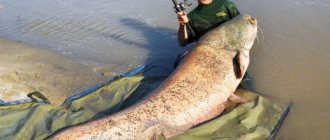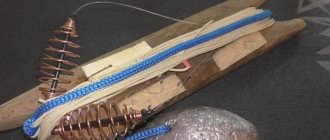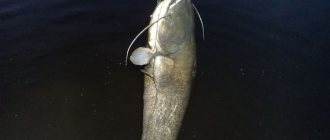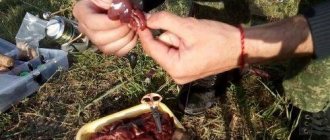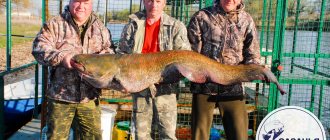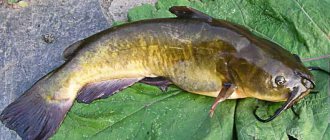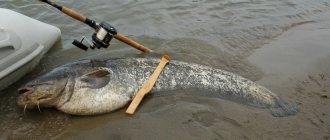Description and behavior characteristics
Catfish is a very large fish, weight can reach up to 100 kg, and length up to 5 m. But this is rare, mostly individuals up to 30 kg are found. His body is without scales and covered with mucus. The color is almost black at the top, the belly is lighter, slightly speckled, with a greenish tint.
It has a huge head and mouth, incommensurate with its body, and small eyes. Whiskers grow on the head, they serve as a kind of tentacles; with their help, the fish can find food even at night. The tail is not at all like an ordinary fish, flat and flattened on the sides.
These are nocturnal predators; during the day they rest in holes, pools, etc. And just before dawn they swim out of their rookery, but not for long. He always behaves differently. It may splash noisily and dive, or show its back a little and then go back into the depths.
Adult individuals change their habitat extremely rarely, having chosen once, they live there alone. Only in wintering pits does accumulation occur. But the young always stick together.
Catfish are greedy, but lazy, they open their toothy mouth and lie there for a long time without moving, waiting for the fish to swim up. Then he sharply draws water into himself along with food. It can openly attack prey and stun it by hitting it with its tail.
Spinning tackle for catching catfish
When catching big fish, spinning tackle experiences enormous loads. When choosing it, the emphasis is on power, reliability, functionality and shock-absorbing properties. First of all, this concerns the rod - it is chosen with a fast action, as strong as possible, long enough (2.7 -3 m) and with a test weight of at least 20-60 grams.
A braided cord is used as a fishing line. The optimal spool size for a power reel is 3000-5000. The length of the leash should be at least 30-40cm.
Depending on the type of spinning bait (jig-head, wobbler, spinner), there are several common methods of catching catfish:
Fishing with wobblers. Each wobbler has its own wiring horizon, which should be taken into account before starting fishing. The wobbler is driven evenly and slowly.
Jig fishing. Large silicone jig baits are suitable for catching catfish at great depths. The wiring of such baits can be stepped (when casting) or uniform (when trolling).
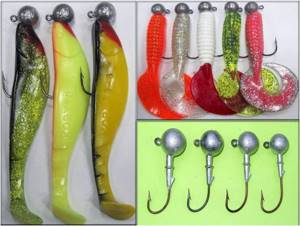
Lure fishing. Large, thick-walled spinners are used as bait. The spoon slowly drags along the bottom, raising muddy currents behind it and simulating moving prey.
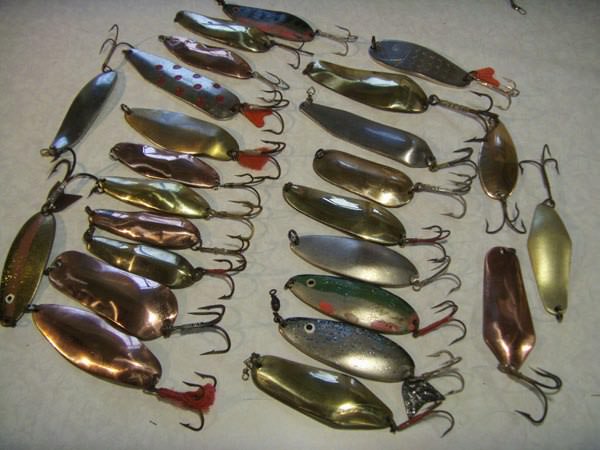
Features of fishing with spinning depending on the time of year:
- In the spring, when the water in the reservoir warms up to 10-120C, the life activity of the catfish is activated, and it leaves its wintering hole in search of prey. It is during this period that catfishing with a spinning rod begins. In search of a fishing spot, promising areas are examined - exits to shallow water from holes overgrown with silt and filled with snags, as well as secluded places under the rubble of bushes and trees, where the sun's rays practically do not reach. The fish, hungry during the winter, is ready to swallow any bait, and the main thing here is to use it correctly. At shallow depths, it is appropriate to use oscillating light spoons and wobblers, moving them evenly, slowly, without unnecessary jerks. Jig baits are well suited for deep water; they are cast in a stepwise manner, tapping the bottom in search of bottom fish.
- In summer, predators prefer to hunt from shelters - deep holes, recesses of washed-out banks, near dams and disperse throughout the entire reservoir. The best time to fish in hot weather is late evening or early morning. The most tempting baits are spoons and wobblers. Uniform wiring is appropriate here.
- In the fall, catfish are predictable, especially with the approach of the first frosts - they do not go far from their wintering grounds and feed intensively on the eve of hibernation, fattening up. Spinning fishing in the autumn is concentrated at great depths using large jig baits and large wobblers.
- In winter, spinners can rest - when the temperature drops to 70C, the predator goes into a wintering hole, where it goes into suspended animation and does not react to external stimuli.
Habitats
This heat-loving fish lives in the Azov, Caspian, Black and Aral seas. At the mouth of the Don and Volga rivers. It is also found in lakes and rivers, but there is not much of it there, so you need to know, more precisely, where they live:
- Behind the bridge supports there are deep water places, but getting to them is difficult.
- Deep holes and pools, with a lot of algae and holes formed at the confluence of 2 rivers.
- Sunken waterfowl, buildings.
- Islands with vegetation separated from the shore.
Fishing calendar by fishing season
- Winter . Of course, you can catch it, but it will be a labor-intensive process. Therefore, many anglers prefer not to do this at this time of year. You need to have accurate data about his rookery and place a well-chosen bait there, then this will be possible.
- Spring . When the water warms up to 8ºС, it begins to show active activity. It leaves the holes in shallow water and begins to actively move in search of food. At this time, it is necessary to use inactive baits: worms, rotten meat, offal, etc. When it gets warmer and the water reaches 15ºC, he begins to really eat, and will eat everything that gets into his mouth.
- Summer . When the water temperature rises to 20ºС, spawning begins; it lasts on average about 20 days. During this period, he cannot be tempted by any known bait; he will not be caught. After spawning, the feeding begins again, and it lasts for a week and a half. After eating, he again becomes inactive during the day. An exception can only be before or after a thunderstorm. You need to hunt only at night, or at dawn.
- Autumn. With the onset of rain and sudden cold snaps, it is not possible to determine his mood. Until the end of autumn it can still sometimes be seen in the shallows. But then he goes to his winter refuge and leaves it less and less often.
When the water temperature drops below 7ºC, it will fall asleep until spring.At this time they hunt for large spinning baits.
Other types of gear for catfish
In addition to classic gear, homemade structures are used to catch catfish from a boat and shore. Some homemade products are superior to store-bought ones due to their ability to handle any kind of prey.
Equipment with underwater float
For many years, to catch the predator, fishermen used a clever tackle - a donk with an underwater float. Its distinctive feature is the location of the float.
Unlike classic bottom fishing, here this part of the equipment is under water, providing additional play for artificial bait or live bait.
The design is a small cylinder or an elongated ellipse, which can be used both in still water and under strong currents. The underwater float is made of materials with good buoyancy, including:
- Cork.
- Styrofoam.
- Other polymer raw materials.
It is not difficult to install a catfish tackle with an underwater float. All materials and available tools are available in the home workshop, and you do not need to use additional equipment to assemble them.
Changeover
Catching catfish in spring or autumn is carried out using a net. This design is made from a durable cord equipped with one and a half meter leashes with hooks. The tackle is pulled from one bank to the other across the river. There are bottom and top models.
The first option is equipped with an additional weight that ensures fixation of the nozzle at the very bottom. The harnesses are stretched over the water or along the surface of the reservoir so that the hooks and bait are at a distance of 30-40 cm from the water.
Spear fishing
Today, such a direction as underwater hunting is actively developing. The use of a harpoon allows you to catch a trophy barbel that is large in size and weight.
Catfish activity increases in mid-May, when the water temperature rises to +17...+18°C. During this period, predators begin to spawn, but there is an official ban on fishing in the country. You can start hunting only after spawning has completed, somewhere in early summer.
With the arrival of summer heat, the river water becomes cloudy, so finding prey in it is problematic. Experienced spearfishers consider autumn to be the best time to dive. Autumn cold improves visibility underwater, providing better conditions for your next dive.
In the fall, hunting river catfish is much easier and more effective. In addition, at this time the largest representatives of the species emerge from the pits, which makes the hunt especially exciting.
Often an underwater gun is used to catch catfish in winter. This is possible under favorable weather conditions, when reservoirs remain open from ice.
Pulse fishing rod
There are less common fishing methods that are prohibited by law, but are still used by unscrupulous fishermen. Among them is the use of an impulse fishing rod. The tackle generates an electrical impulse that affects defenseless fish, killing it instantly.
In addition to large individuals, fry and young fish float to the surface. Many of them die, but the rest are damaged and can no longer reproduce.
What homemade tackle is easiest to assemble with your own hands?
It’s not difficult to assemble homemade gear for fishing for catfish. But some options have an intricate design and require installation skills. The rest are quite simple to make, so even a beginner can make them.
Among them is the classic donka. To create the tackle you will need a strong cord, a large hook and a heavy sinker. The latter equipment is cast independently from lead or purchased at a fishing store.
Particular emphasis is placed on the quality of the fishing line. For a homemade product, use a twisted or braided cord that can withstand loads of up to 50-60 kg. The optimal fishing line length is 50−100 m.
Single but large models made of 5-6 mm strong wire are used as hooks.
It’s not difficult to set up catfish supplies with your own hands. It is enough to prepare the necessary equipment elements and connect them one by one. A good homemade product allows you to catch catfish in winter and summer with equal efficiency.
Basic methods of catching catfish
There are dozens of different types of fishing. The most popular: fishing rod, spinning rod, coastal donka, quok, etc. You just need to always remember that this fish is bottom-dwelling. This means that the gear is compiled based on the specifics of bottom fishing.
Na kwok
Kwok comes in different structures
A kwok is a kind of mallet, hitting the water with it will produce characteristic gurgling sounds. It is made from a variety of materials: wood, metal and mixtures. If you wish, you can buy a ready-made, factory-made one, of various designs.
Such a blow resembles a loud click. The barbel leaves its shelter and immediately heads towards the source of the sound. No one knows for sure what attracts him. Maybe it's just the call of a female, or ordinary curiosity.
It is not difficult to master the game of kwok; they make 5-6 strikes on the water with minimal depth. They pause and repeat again. But the best way is to fish from a boat.
Catfish fish only from May until almost the end of September.
To the donka from the shore
You can also catch it from the shore, but not a trophy specimen. If possible, position yourself next to a catfish hole, on the shallows. This will increase your chances significantly. From the shore, throw the bait within the reach of the fish.
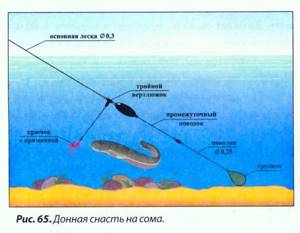
Bottom tackle for catfish
The donka must be of special strength:
- Leash: Ø 0.2–0.16 mm.
- Monoline: 0.5-1 mm.
- For large individuals, a braid is needed: Ø 0.6–0.9 mm.
- Hooks: No. 10–16, for bait, tees are often used.
- Sinker (sliding): up to 120 g.
- The coil is at least 4000.
Leashes must be attached to a fishing line with a carabiner.
In the spring, large live baits up to 300 grams are used for bait: worms, live bait, loach, gudgeon, crawler . The catfish comes close to the shore, so there is no need to make long casts.
In summer - add locusts, shells, mole crickets and leeches . You need to start hunting only in the dark. Place the fishing rod on the stand, loosen the friction brake on the reel and install a bite alarm.
For spinning
Super Shad Rap
It should be very powerful:
- Length - 2.6-3 m.
- Test - 70-100 g.
- Reel - at least 200 m of line.
- Braid, up to 30 lb.
- For a twister, the cord is 50 lb.
If you have to hunt up to 20 kg, the tackle can be made shorter.
Lures: deep wobblers, spoons, jig baits.
An effective bait is a Super Shad Rap ; during retrieval it will emit a strong vibration.
Execution of fishing gear
From the gear listed above for catching catfish from the shore, you can make various designs. Depending on the degree of mechanization, the casting range is provided from 30 meters when using the device without a reel, to 100 m when using a heavy-class spinning rod. Features of some fishing gear:
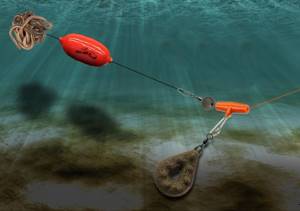
The zakidushka is a popular tool; even a beginner can do it. The basis is a reel - a piece of plywood or plastic with oblique slots on opposite sides for winding the working cord, fishing line with a leash equipped with a hook and sinker. The bite alarm is tied up after casting and securing on the shore 5-10 hooks with a distance between them of 4-9 m. You can do without an alarm if you check the tackle in the morning.- Donka with a reel and a feeder differ only in the flight range of the bait. The rods are powerful spinning rods made in China, or heavy feeders (Heavy Feeder, Extra Heavy Feeder) for loads from 120 g with powerful traction reels. The equipment of bottom rods is the same as that of casting rods. The main difference from the simplest tool is the smaller number of simultaneous work: 3-5 units. They are not left unattended even at night: they are equipped with sound and light alarms.
- Spinning differs from donkeys in its mobility and in that it is used in a single copy. Weighty oscillating spoons are often used as bait, less often - deep-sea wobblers and silicone on heavy jig heads - hooks combined with a sinker.
There are other names for fishing gear: girders, circles, paths, quok. All these fishing gear are derivatives of the devices listed above.
Types of bait for catfish
There are many baits, especially of artificial origin: twisters, wobblers, vibrotails, silicone fish, etc.
But despite this, many prefer to use the old fashioned way: worms, live bait, frogs, locusts, etc. And they believe that this is a more affordable and tasty food.
Organic origin
We can highlight:
- Crawling worms (whole bunches) - used by more than one generation of catfish, especially effective for small and medium-sized specimens, in the spring, when it gets warmer.
- The shell is a good delicacy; you can find it in a body of water where there is a current. Large shells are collected and the contents are removed using a knife.
- Scorched or lightly smoked poultry carcasses - Suitable for hunting large specimens. The bird is very strongly scorched over a fire, until it smells like burnt feathers and flesh. They let it rot and hang it entirely on the hook.
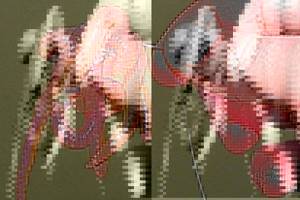
Crawls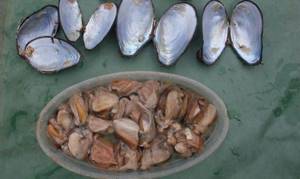
Shell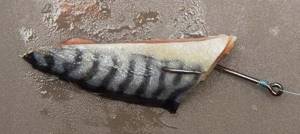
Piece of fish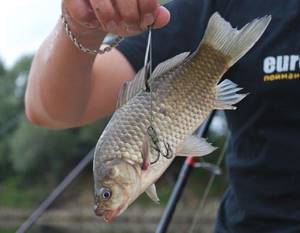
Zywiec - Pieces of meat and fish - the main thing is that they have a foul odor. In this form, they are cut into pieces of the desired shape and planted.
- Zywiec. The word live bait applies to any type of fish. The size is selected according to the dimensions of the catfish. You need to at least approximately imagine the size of the future trophy.
The main condition for live bait is that it must be alive and caught in its own reservoir.Catfish pose a natural danger to small fish. This means that they will frantically try to escape, and this will attract the predator even more.
Artificial origin
For spinning it is better to use a wobbler, some models:
- Liberty BITE 130F.
- Liberty Deep Runner 800F.
- Dorado Invader 8F and 7S.
- SalmoPerch P08SDR.
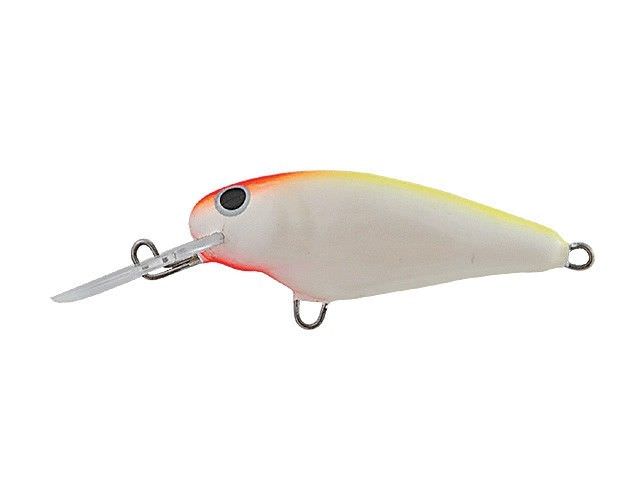
Dorado Invader 7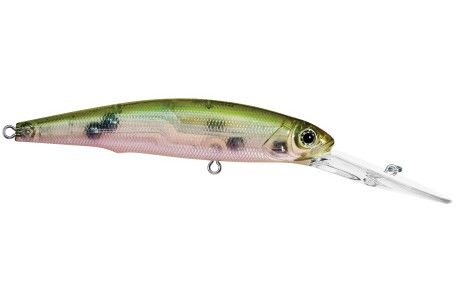
Liberty BITE 130F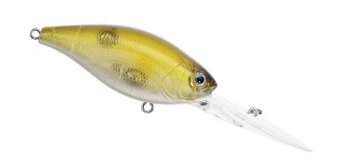
Liberty Deep Runner 800F
Salmo Perch P08SDR
They have a good game: uniform, not very fast wiring. A wide variety of colors, very stable in operation.
For jig hunting , baits made from edible silicone are ideal; the choice is simply huge.
All bodies of water have their own unique features, so the choice will depend only on them.
When going on their next fishing trip, experienced fishermen take with them all the bait they have available. As they say, for all occasions.
The best lures for fishing with quok
Fishing with a quok involves attracting catfish to the bait with the sound of a quok. And the bait is only needed to provoke him, so that he swallows it and gets caught.
The following are good attachments:
- Pearl barley shell. This is a bivalve mollusk. They are collected in advance, in the shallows. They need to be stored in water, and when fishing, carefully open the shell with a knife and remove the mollusk. Place several pieces on the hook at a time; they should hang freely from the hook, but the tip should be open.
- Frog. It is necessary to catch frogs that are local, living near the habitat of the catfish, he subtly senses the difference. It’s good to do this at night with a flashlight; blinded by the light, they freeze in place. It is better to place them on the tee, just do it without damaging it. She must remain alive for a long time and must be mobile. The sting is passed from the back, through, next to the anus, with a slight deviation from the spinal column, slightly to the right or left. If after this execution she remains alive and vigorously twitches her hind legs, then you did everything right.
- Bark beetle larvae. They are very meaty and dense. They can be found in the forest on a rotten trunk or stump of any tree. If the tree below is strewn with sawdust, and there are round holes in the trunk, it means that the bark beetle has settled there. This is an excellent protein food; catfish simply love it.
- Pieces of fish and meat. You can take any meat or fish that is unnecessary on the farm. If it is relatively fresh, it needs to be spoiled a little, the smell should be as foul as possible.
- The bird is scorched. This type of bait has a stimulating effect on the big-headed predator’s sense of smell. You can take any carcasses, both domestic and wild birds: small chickens, sparrows, pigeons, etc. The plumage just needs to be severely scorched over a fire. And let it lie a little warm, when the smell appears, you can go fishing.
- Locust
Locust and mole cricket. Mole cricket has a specific smell that the barbel likes so much. It's not easy to dig out of the ground, but it will be worth it. There is especially a lot of it in vegetable gardens; its favorite place is under heaps of last year’s manure. Locusts are a little more difficult to catch; they live on agricultural lands, destroying them en masse. There is an alternative, buy it at a fishing store. - Cancer. This is also a bottom dweller, which is probably why it is so attractive. They should only be alive, so you need to learn how to plant them correctly.
You can't pierce the tail with it, it will die so quickly. A puncture is made on top of the shell, slightly above the eyes.Such a nozzle on the bottom will look very natural, because he will run and defend himself and move. This means that our predator will definitely notice it, and will not remain indifferent.
- Perch and other large baitfish. The catfish is an omnivorous predator; its main diet consists of fish. For large predators, it is necessary to take larger live bait, such as: perch, bream, burbot, crucian carp, asp, tench, pike, ruff, ide, loach, roach, chub, etc. The optimal weight is up to 200 grams. For large prey - up to 2 kg or more.
- Worms in a bunch. This is the simplest bait that has been used productively for many years - worms.
A bunch of worms (10-20 pieces) strung on a hook always serves as an excellent bait for absolutely all bodies of water and time of year. The worms just need to be strung on a tee so that the barbel does not break off when biting.
Catfish bait in spring
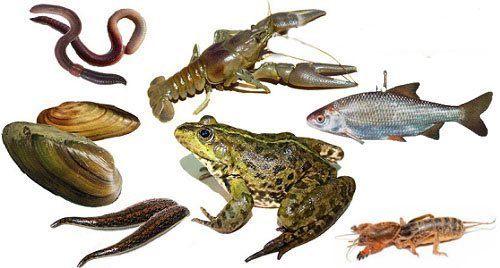
In the spring, the catfish wakes up from hibernation and gradually begins to gain activity. The first activity of catfish and its bite can be observed already in April. It is best to navigate by the water temperature and when it reaches 10 °C you can be sure that the catfish has already gone hunting.
While the water is not yet warm enough, catfish can be found even in shallow water and it is not at all necessary to look for deep holes to catch catfish. And although the catfish is considered a nocturnal predator, in the spring, while the water has not yet completely warmed up, the catfish can actively feed during the day and not respond to bait at night.
At this time, the catfish bite is not yet stable. It may periodically delight with frequent bites, or it may not make itself known at all for several days. And when the water temperature rises to 18 °C, the catfish begins spawning, which lasts about 2.5 weeks. After spawning, the catfish has a short break, after which this huge predator develops a good appetite and begins to eat. But this happens already in the summer, but for now let’s return to spring bait for catfish.
The variety of spring baits for catfish is very large. After wintering, catfish take equally well on any bait, naturally of animal origin. It can be:
- Crawling out . Placed on the hook in a bunch of 2-4 pieces. The crawler is an excellent bait, but large catfish are caught on the crawler extremely rarely and the main catch with such bait is catfish up to 3 kilograms.
- Zhiwiec . Live bait is one of the favorite delicacies of catfish. You can use absolutely any type of fish as live bait, but it is advisable to fish with live bait that was caught in the same body of water. Catfish bite much more actively on local live bait. The choice of fish as a live bait will depend only on what size catfish you are targeting. To do this, you must start from the fact that the size of the catfish that will bite your live bait will be at least 6-8 times larger than the bait. If we are talking about catching small catfish, then brushes, minnows, and perches are suitable as live bait. But for catching large catfish over 5 kg, it is better to choose crucian carp or roach.
- Frog . Frogs are the catfish’s natural food to which it is accustomed. This is why using a frog as bait can bring good results. The frog is caught on a hook by the lower jaw or legs.
- Sparrow . For those who are not particularly familiar with catfishing, using a sparrow as bait may seem like a joke or stupidity. But don't rush to conclusions. Sparrow roasted over a fire is one of the best baits. And in some regions, when asked “What do you use to catch catfish,” people answer in surprise, “Fried sparrow, of course,” as if there was no other bait. In order to catch a sparrow, various traps are used, which are quite easy to build and lure the sparrow into them with food.
- Perlovitsa . Pearl barley is a bivalve mollusk. It can often be found in rivers and ponds. Catfish also readily bite on the meat of this mollusk.
- Locust . A few insects such as locusts attached to a hook make excellent bait for catfish. Usually about 4 locusts are put on a hook.
- Chicken liver . Another popular bait for catfish is chicken liver. Chicken liver that has been left in the sun may be more attractive to catfish, as it will give off an odor.
- Pieces of fish . Catfish are excellently caught using pieces of fish. You can use a fish's head or tail. Often, in different bodies of water, catfish prefer a certain part of the fish. On some reservoirs, catfish are excellent at catching exclusively on the tail part, and on some, on the contrary, on the head of the fish. A purchased goby in tomato can also serve as a piece of fish. In some reservoirs, this bait attracts catfish more than others. You can use a whole bull, or again in parts. Try different options and watch the catfish’s reaction. By choosing the right key, you can regularly catch this freshwater giant.
The best lures for donk fishing
An adult predator is not very picky about food; it eats everything that is in its pond. But small and medium-sized catfish each have their own diet.
For small fish
Black leeches
Best lures:
- small river shells;
- black leech;
- crawling out.
For average individuals
Best lures:
- small frogs;
- small fish - live bait;
- cancer.
For large production
Frog
Best lures:
- field or house mice;
- large fish - live bait;
- a bird singed at the stake.
Artificial baits for spinning fishing
There are many artificial baits for spinning; the list of them can take a very long time. But the most catchy ones for the mustachioed predator are wobblers, spinners and silicone.
Wobbler
floating wobblers - they are equipped with a blade and have an average diving depth. Great for the summer season, near the dams of huge rivers. After darkening, the barbels swim into shallow water, in places where small things accumulate.
They drive the wobblers in jerky movements, pausing so that the bait can float up. The barbel always bites when the wobbler starts moving again. The length of the wobblers should be 20 cm.
Rapala Countdown Magnum 22
Sinking - when the temperature drops in the fall, catfish move to deeper layers, and that’s where you need to look for them. The best bait at this time will be wobblers, sinking with a semi-passive game. Postings must be done slowly. Hunting at this time:
- rivers - in whirlpools, next to the harbor.
- lakes - in deep-sea places.
A very good wobbler from Rapala Magnum .
The fish is inactive at this time, and therefore you need to give it a little rest by stopping the bait.
Silicone
Large edible and inedible silicone fish (10-25 cm) are suitable for spinning, especially in spring and autumn. At this time it lies in the bottom layers.
On the river, silicone is used in whirlpools near dams, at the confluence of two rivers, etc.
In lakes - at depth, near catfish shelters. Barbel has a good sense of smell, so the fish should not have a pungent synthetic smell. You can treat it with purchased flavorings, or keep it in a bag with fish for a couple of days.
Spoon
Effzett
Barbels are very tempted by the loud sound of bait. For night hunting, a heavy spoon is suitable, for example, a two-layer one - Effzett . It makes noise when lowering and a clicking sound when moving.
To explore a place and fish, you can throw the bait into the same place 20-30 times without worrying about the noise it makes.
This individual bites on a noisy bait only after it has been repeatedly lowered into the water.
When using this wiring technique, you need to pay special attention to the speed of regaining control of the nozzle. Because when hunting for a lure, the bite can begin almost immediately after casting.
In order not to lose control of the bait, when casting you need to slow down the flight a little. This will ensure instant hooking when biting.
Why is catfish caught using a spoon?
In general, catfish is a predatory fish, so it is quite logical that it will hunt fry. Moreover, it will hunt more actively in cases where the food supply of the reservoir is not very rich. Such a huge fish cannot be content with larvae, bloodworms and small worms. Catfish readily eat crayfish and large worms. But if all this is missing, then it moves on to everything that moves: toads, rodents and fish. And the larger the prey, the faster he will satisfy his hunger.
The nuance is that catfish are sedentary fish. He will not, like pike or pike perch and asp, cover kilometers in search of active fry. He hunts only near his holes and picks up all his food at the bottom. Early in the morning and after lunch he goes out on an active search. Seeing a school of catfish hunting for fish is worth a lot. When the catfish begins to hunt, a school of chubs or roaches flies up. This means that some individuals were unlucky and ended up in the huge mouth of a catfish.
During the day, catfish hunt those fish that are in the middle and upper layers of water. At night, he hunts in the bottom layers. That's why donkeys usually try to catch it at night. Spinning fishermen keep this feeding feature of catfish in mind. During the day they lead baits in the water column and in the upper layers, and at night they fish with heavy spoons that play well in the bottom layer.
Techniques and tactics for catching catfish
Wiring parameters - measured, unhurried movements of the rod:
- The wobbler needs to be buried no more than 30-40 cm from the bottom.
- Jig fishing - take edible or inedible silicone fish and heavy spoons.
- When casting, they are caught with silicone baits and oscillating spoons.
- Trolling - diver wobblers.
In particularly intense currents, use spinning rods: test 60-150 or more.
In low currents and standing water:
- test - 30-80, heavy class;
- multiplier reel - 5500-6000;
- braid, with breaking load - 15-25 kg.
You can take any bait, for example : foam rubber, silicone fish, various kinds. They should be equipped with a 20-50 g weight at the front.
The principle of wiring is that the bait must pass the bottom in jerky movements.
Make several turns of the coil, followed by a long pause - 10-15 seconds. The bite is a bit like a hook. Only after 7 seconds will the catfish come to its senses and begin to resist. When fishing with a spoon (spoon), the game drags on, it is sluggish and unpredictable, sometimes it needs to be interrupted for 4-7 seconds.
Sometimes a spinner may also be of interest. In small lakes and rivers you can catch it using oscillating spoons. In large areas, catchable ones are deep wobblers with a dive of up to 5 m. At night, use baits moving near the surface of the water.
Catching catfish with a spoon in a plumb line
This method is most effective at depth during the day and morning. It consists of sequential movement around the territory of the pit in which catfish are supposed to be found. In this case, homemade tackle can also be used with replanting a whole fish, which is especially effective at great depths. However, since catching catfish with a spoon using this method is carried out from a boat, it must be equipped with an anchor capable of holding it in the fairway for a long time.
As for the bait, its weight is usually selected taking into account the speed of the river flow and can range from 150 to 200 g. You can check compliance as follows. A freely launched spinner should not deviate more than 25°. The color and shape can be any, but according to the observations of experienced soyatniks, it is still preferable to choose bright silver or red-orange elongated models.
Tips and tricks
- They fish all day before spawning - when the water becomes lighter and the flood level drops.
- After spawning - at great depths, near steep banks, at the exit of holes, near whirlpools.
- In summer - more often, immediately after darkening. At night until sunrise, this time can be very productive.
- Small catfish are often found during the day. But the larger ones are cautious, so you should hunt for them only in the dark.
- Large specimens are caught:
- on moonlit, clear nights;
- during a thunderstorm, they rise to the top.
- Take a hook and a heavy mallet, if you catch a large fish you won’t be able to do without this tool.
- You shouldn’t go fishing alone, you shouldn’t take risks, there are different situations.
- Every catfish you catch will be remembered for the rest of your life. Therefore, be patient, have bait, and have a fishing spot, and this big-faced and mustachioed fish will definitely be yours!
Lures
The best artificial baits for catfish are:
- Large oscillating spoons. This type of bait can only be used in places where the bottom is sufficiently clean, where there are no tree roots, submerged objects, or snags on the bottom;
- Deep-sea large wobblers (the preferred form is a minnow or an exact imitation of a ruff) This type of bait can only be used in places where the bottom is sufficiently clean, where there are no tree roots, submerged objects, or snags on the bottom;
- Jig baits (twisters, slugs, frogs), which work well in early spring, when catfish are just emerging from hibernation and hunting for everything that moves. This type of bait can be used in combination with an offset hook in the most difficult places for any spinning angler - in snags and dense thickets of aquatic vegetation.
- Surface baits (poppers, artificial mouse, frog imitation). It works best in the heat of summer and when catfish are active in the fall. There are different techniques for catching catfish with live bait.
Advice! You need to choose bait for catfish based on the activity of the catfish in the pond. If the catfish rises to the surface (characteristic squelching sounds are heard), then it is better to prefer surface baits. If the catfish is not visible or heard at the surface, then you need to use bottom baits.

